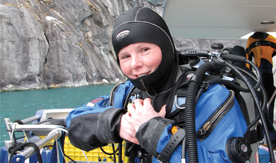
National Geographic Magazine Lauds UMaine’s ‘Ice Water Diver’
University of Maine marine scientist Rhian Waller is heralded as a risk taker in “New Age of Exploration” in the March edition of National Geographic Magazine.
The National Geographic Society, one of the largest nonprofit scientific and educational institutions in the world, is celebrating its 125th birthday in 2013 with a yearlong series that highlights 21st-century explorers who “press the limits.”
Waller, a University of Maine assistant research professor in the School of Marine Sciences who works at the Darling Marine Center in Walpole, Maine, has pressed the limits of diving during more than 40 expeditions around the planet. In a submersible, she once plunged to a depth of 3,600 meters for corals on the New England Seamount chain in 2005. She frequently scuba dives in temperatures of 35 degrees F and below in the name of science.
Her research focuses on how environmental factors such as climate change, fishing and oil exploration affect deep-sea coral ecology and reproduction, as well as what effect that altered life cycle could have on the rest of the marine ecosystem.
“You can imagine all it takes is one trawler or one piece of garbage to land on the coral and suffocate it, and that’s 4,000 years of growth and 4,000 years before that colony will grow back to support 1,000 different invertebrates, which in turn support maybe tens or hundreds of different species of fish,” she says.
The question-and-answer piece with Pat Walters on page 121 of National Geographic Magazine is titled “Ice Water Diver” and includes a portrait by Emmy Award-winning photographer Marco Grob.
In January 2013, Waller conducted research along fjords near Juneau, Alaska, where red tree coral forms essential habitat for rockfish and crustacean species. She is examining how healthy the coral is, when and how much it reproduces, and if there is a specific time of year when it should be protected because it’s reproducing.
Last summer, Waller traveled to Chile to study reproductive ecology of deep-sea corals. National Geographic and the National Science Foundation funded the study, which allowed her to establish three long-term sites that she’ll monitor and from which she’ll take coral samples.
Waller says her goal with each research project is to demonstrate the importance of deep-sea coral systems to the rest of the ocean ecosystem. “If we continue to damage these coral habitats, we’re going to damage the fish and invertebrate populations that live around them,” she says. “Even though they’re out-of-sight, out-of-mind, and many people don’t know they’re there, we have to explore and research why these ecosystems are important.”
Waller’s fascination with the beautiful, mysterious, slow-growing marine animals called corals was sparked when she snorkeled in the Red and Arabian seas as a youth.
While overlooking Tracy Arm fjord near Juneau, Alaska a month ago, Waller, 34, blogged for National Geographic: “This is one of those rare places, where fewer divers than you can count on one hand have dove and seen. Where even the marine radio won’t reach and you’re completely out of touch with the rest of humanity. Where when the sun shines on the top of the mountains and glistens off the aquamarine ocean, the scale of this glacial cut fjord becomes instantly apparent, and you feel so small. I think it’s important we take ourselves places where we can feel small occasionally, to remind us that we are protectors of our lands and our oceans, and to understand it we need to explore it.”
The online edition of National Geographic Magazine was available Feb. 15; the magazine is scheduled to hit newsstands Feb. 26.
The winter issue of UMaine Today magazine features an in-depth look at Waller’s research.
Contact: Beth Staples, 207.581.3777
